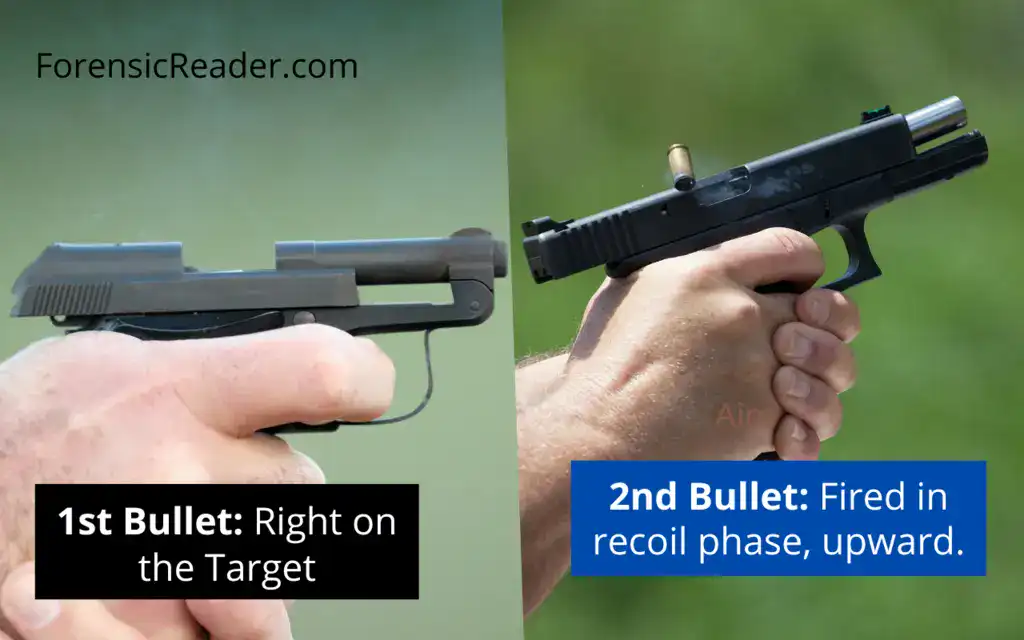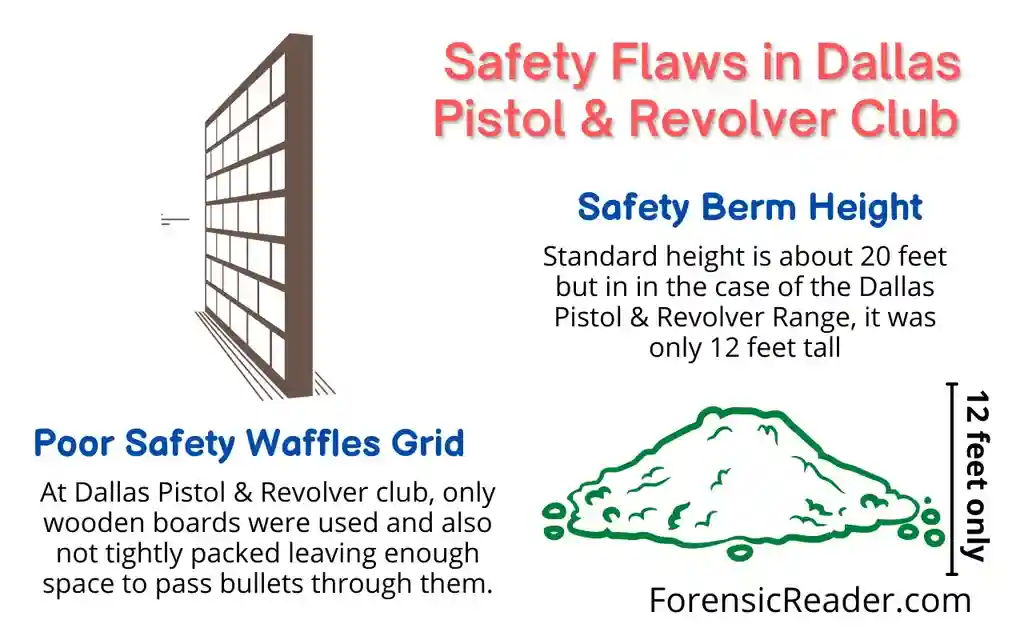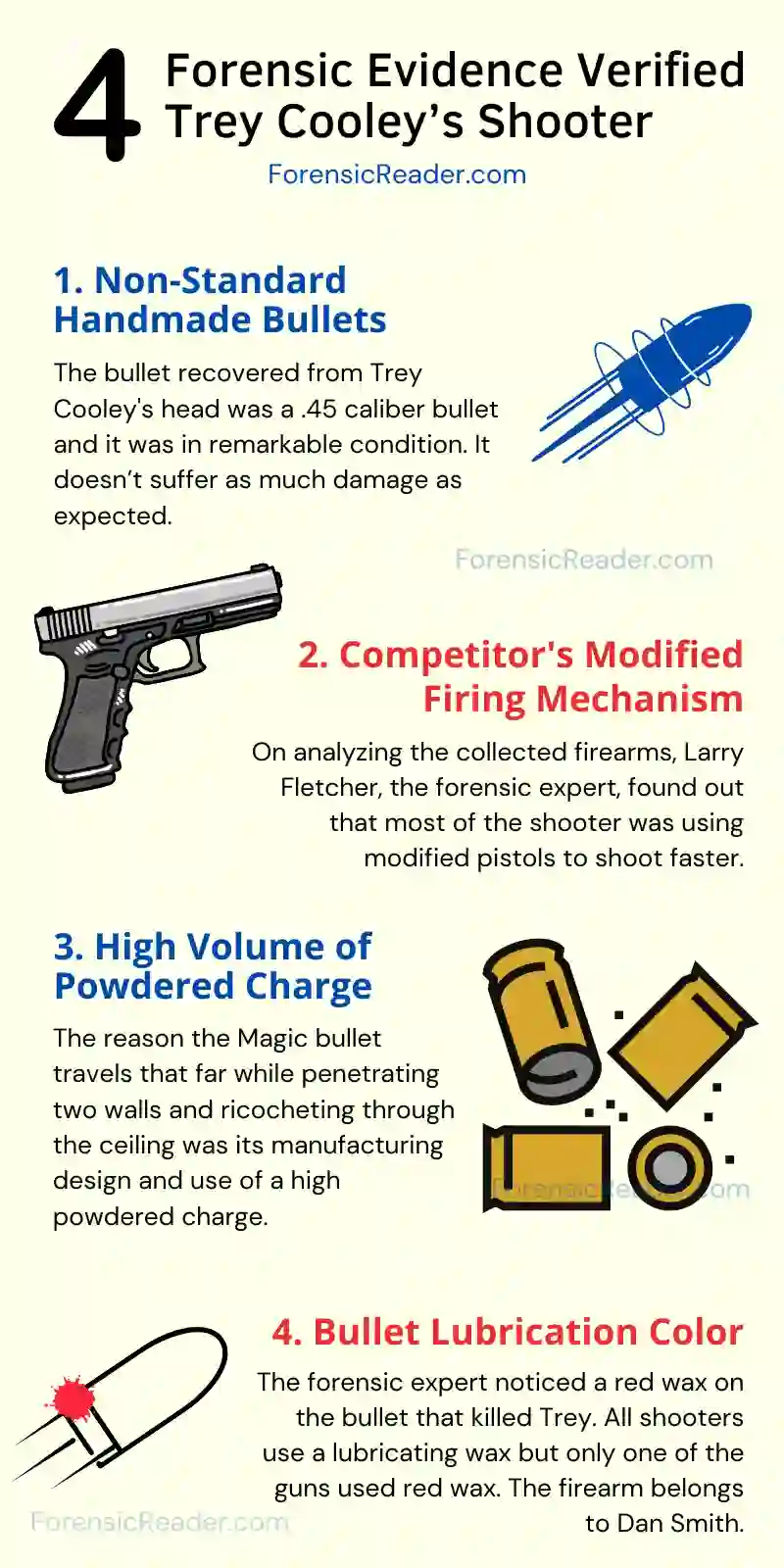When a bullet leaves the firearm, there is a straight path that it follows. But in “The Magic Bullet” case of Trey Cooley, a bullet hits nearly 4 intermediate targets. Forensic animation helps the case in determining its path of travel.
With this article, I try to focus on the forensic approach that helps the case. The case study is based on The Magic Bullet case of Trey Cooley aired on Forensic Files, Season 1, Episode 2.
Summary of Trey Cooley [The Magic Bullet] Case
On September 29, 1991, at Dallas Pistol & Revolver Club, a young 15-year spectator, Trey Cooley (Leland Harold “Trey” Cooley III), was struck by a stray bullet when he was sitting behind an air gun range.
The bullet enter his temple through a white baseball cap that he was wearing. Trey was rushed back to Parkland Memorial Hospital in Dallas where he was declared dead after six hours.
Police investigated two possibilities for where the bullet came from (1) shooting in an outdoor yard or (2) shooting from railroad tracks near the air gun building where Trey Colley was sitting.
Trey Cooley’s father, Leland H. Butch Cooley, hired an attorney and 3D forensic reconstruction expert to reconstruct the incident in order to learn how his son was killed.
3D animation depicted the full story of how the bullet travels unexpectedly from the outdoor shooting competition. On investigation, it was discovered that there were many safety loopholes that could prevent the unfortunate incident.
Cooley’s family filed a negligence suit against the club and the competitors. They received a settlement of more than $3 million dollars.
Investigators and Forensic Experts in Trey Cooley’s The Magic Bullet Case
For investigation, detective Tom Pease and crime investigator David Taylor were assigned to determine whether Trey Cooley’s death was accidental or intentional.
Larry Fletcher was assigned as a forensic firearms expert in this case and concluded that it was fired from Dan Smith’s pistol (a competition shooter).
Trey Cooley’s father Leland H. Butch Cooley II hired attorney Mike Schmidt that lead the forensic laser 3d reconstruction animation experts (Steve Irwin) to trace down the path of the bullet that hit his son’s skull.
Forensic Animation Reconstructed Story of The Magic Bullet Case of Trey Cooley III

The Magic bullet case can be easily understood in four phases:
Phase 1: Dan, the Shooter
On September 29, 1991, there was a shooting competition at Dallas Pistol & Revolver Club.
Dan Smith, a shooter stepped to the 15-yard line and fired from his pistol which was modified to decrease the shooting time.
Phase 2: Second Bullet Fired in Recoil
On squeezing the trigger, the first shot was fired, and within a fraction of a second, another shot was fired during the recoil phase, which points the pistol’s muzzle above the shooting point. Dan Smith was unaware that a second shot get fired accidentally.
Phase 3: Upward Trajectory
Following the upward trajectory, the bullet misses the wooden protecting wall and berm behind the shooting range by 3 inches. The bullet then enters the airgun building by punching a hole in the aluminum siding.
The bullet then passed through a storage room (missing broom and pipes by an inch), hit another wall, and ricocheted downward from the ceiling tile.
Phase 4: Pushed Downward by Ceiling
Following the downward trajectory after ricocheting from the ceiling, the bullet penetrated a plaster wall and finally ended up in Trey Colley’s head.
Who was The Culprit of Trey Cooley in The Magic Bullet Case?
It was an accident. But can be avoided. There was no intention of deliberate harm. However, two major reasons for Trey Cooley’s Magic Bullet incident:
- The shooter, Dan Smith’s modified firearm and ammunition, and
- The Dallas Pistol & Revolver Club’s failure to follow safety guidelines.
How Dan Smith’s Modified Pistol and Ammunition Killed Trey?
Dan Smith’s modified pistol and ammunition were one of the reasons he didn’t realize his gun shoots another bullet in the recoil phase, which pointed far upward than the normal range targe.

Why did Dan Smith use a Modified Pistol?
It was common among competitor shooters. They usually modified their pistols to reduce the reloading and trigger mechanism in order to shorten the time between two shots.
This was why the second shot was fired during the recoil phase without Dan’s knowledge.
Why Did Dan Smith Use His Own Ammunition?
Competitor shooters save money by making their own ammunition instead of purchasing standard ammunition.
A. Make their own Hard Projectile
Most of the competitors use steel cores to make the projectile. They were usually made by punching the steel core tube in a hydraulic press.

Dan Smith also used the same type of projectile core. That’s why the bullet that hit Trey Cooley’s head was not fragmented or damaged. The bullet that killed Trey Cooley hit more than four intermediate targets and was still not fragmented/damaged enough.
If Dan Smith had used standard ammunition, there is no way it can pass through these walls.
B. Extensive Use of Powder Charge
The speed of the projectile is determined mainly by the powder charge. Speed increases the power to penetrate and extend the range.
Dan used a non-standard high powder charge in his ammunition (bullet + cartridge case), which accelerated the bullet to a very high speed of 1,200 feet per second.
Conversely, standard bullet ammunition for handguns can achieve a speed of up to 900 feet per second (commonly). Thus, if a standard powder charge was used by Dan, it would never travel that far and hit so many intermediate targets.
Read More: Killer’s Cattle Log Scam [Forensic File] Case: Ray and Faye Copeland Case
Safety Flaws in Dallas Pistol & Revolver Club in Magic Bullet Case

Dallas Pistol & Revolver Club didn’t follow the safety guidelines and had two deadly safety flaws. They were as follows:
1. Poor Safety Waffles Grid
Full-proof safety waffles should have a wooden face backed by a steel or concrete wall.
At Dallas Pistol & Revolver club, only wooden boards were used. In addition, they were not tightly packed leaving enough space to pass bullets through them.
Surprisingly, it was not the first time bullet passes through those safety waffles. Many of the bullet holes were identified by investigators on the aluminum siding of the air gun building that faces the outdoor yard.
Authority and shooter know bullets were passing through the safety waffles but no one takes any action.
2. Non-Standard Safety Berm Height
In firearm ranges, a safety berm is a land raised to shield the bullet from escaping behind the range. The average height of a safety berm in the United States is around 20 feet.
But in the case of the Dallas Pistol & Revolver Range, it was only 12 feet tall, which was 8 feet shorter than the standard height.
What and How Forensic Evidence Verified Trey Cooley’s Shooter?

Larry Letcher, a forensic ballistic expert, needed test bullets to compare with the bullet that hit Trey’s head. For that, all pistols, as well as live ammo, were taken from the competitors who were shooting in the yard on that day (September 29, 1991).
Live ammunition was fired from respective pistols in order to get a reference sample for comparison.
Following are the findings of Larry Fletcher on Trey Cooley’s The Magic Bullet Case:
Finding 1: All Competitors Using Non-Standard Handmade Bullets
The bullet recovered from Trey Cooley’s head was a .45 caliber bullet and it was in remarkable condition. It doesn’t suffer as much damage as expected.
The forensic expert concluded that it was a hand-made bullet that can withstand certain damage.
But this doesn’t conclude which competitors firearm shoot the bullet that hit Trey Cooley because most of the competitors had used non-standard handmade bullets with the same caliber.
Finding 2: Competitor’s Modified Firing Mechanism
On analyzing the collected firearms, Larry Fletcher found out that most of the shooter was using modified pistols to shoot faster.
There was no way Larry Fletcher can use a pistol alone to point out the firearm that kills Trey Cooley.
Note: When only bullet and firearm are available for comparison (no cartridge case) the most important identification markers are the land and groove marks and twisting over the bullet.
Finding 3: High Powdered Charge— Again Non-Standard
The reason the Magic bullet travels that far while penetrating two walls and ricocheting through the ceiling was its manufacturing design and use of a high powdered charge.
Larry Fletcher stated that shooters were using a high amount of gun-powder that created extremely high temperatures during the firing of the gun that melted some of the distinguishing marks.
I think Larry Fletcher means to say that:
- The bullets were hard that resist marking from rifling in the barrel.
- And even if the marks on the surface were made when the bullet was traveling through the barrel, high pressure generate by too much gunpowder forces high-temperature gases these land and groove and smudges the marking over the bullet.
What are the distinguishing marks on the bullet? Land and grooves marking (rifling marking), angle of twist, and color-coded tips are the most common comparison marks used by forensic experts.
Finding 4: Bullet Lubrication Color
Lubrication is used to make the transition of bullets smooth during the manufacturing, loading, and firing mechanism.
The forensic expert noticed a red wax on the bullet that killed Trey. All shooters use lubricating wax but only one of the guns used red wax. The firearm belongs to Dan Smith. He also finds other resonating features such as bullet builds and high powder propellant.
Fletcher’s findings were proven to be true by a forensic 3D animation model (by Steve Irwin) that depicts the path of the projectile and how it hit Trey’s temple.
Who is Trey Cooley’s Father, and His Influence On Case?
Trey Cooley’s father is Leland H. Butch Cooley II. He was in the shooting yard on that day with his son.
Butch Cooley was the one who hired attorney Mike Schmidt that lead the investigation with the help of a forensic 3D animation expert to trace the part of the bullet.
The judge also appreciates the descriptive nature of the evidence presented in court, which was only made possible by Leland Butch Cooley’s efforts to discover the truth about his son’s death.
Final Verdict of Court and Settlement
- The case was registered for negligence on both: the Dallas Pistol & Revolver Club and the competitors that were shooting that day.
- A sum of more than $3 million was given to Trey’s family for their loss.
- Dallas Pistol & Revolver club redesign the safety measures in the indoor air gun area and closed the outdoor shooting range.
Watch the Whole Episode: Forensic Files: Season 1, Episode 2 on Amazon Prime.
Read More:
- Shot of Vengeance Case Study: Janice and Evil Dr. Schmidt Forensic File Case
- Gone Ballistic Case Study: 20-Year bullet Solves the Case of Alan Helmick
- Color-Coded Bullets Tips [Tables]: Different Types and Their Uses

FR Author Group at ForensicReader is a team of Forensic experts and scholars having B.Sc, M.Sc, or Doctorate( Ph.D.) degrees in Forensic Science. We published on topics on fingerprints, questioned documents, forensic medicine, toxicology, physical evidence, and related case studies. Know More.
